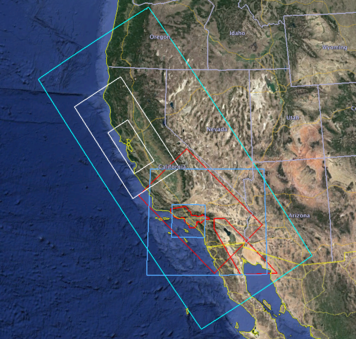UCVM
The Unified Community Velocity Model (UCVM) software framework is a collection of software tools designed to provide standard interface to multiple, alternative, California 3D velocity models. One important use of UCVMC is in high resolution 3D wave propagation simulations for California. UCVM development is an interdisciplinary research collaboration involving geoscientists and computer scientists. UCVM geoscience research includes identification and assembly of existing California velocity models into a state-wide model and improvements to existing velocity models. UCVM computer science research includes definition of a easy-to-use CVM query interface, integration of regional 3D and geotechnical models, and automated CVM evaluation processing capabilities.
Contents
UCVM Github Repository
The current UCVM software distribution has been moved to a public github repository. The master branch of this repository is the current UCVM release.
UCVM Introduction
The Unified Community Velocity Model (UCVM) software is open-source scientific software designed to support earth scientists, civil engineers, and other groups interested in detailed information about earth properties. UCVM is primarily used by scientists to work with earth material properties on regional scales.
UCVM software provides a software interface to one or more existing earth structure models. The earth structure models can be used directly without requiring UCVM. While UCVM adds complexity, it provides software capabilities that may be valuable to researchers. These UCVM specific capabilities include:
- Provides standard query interface to multiple CVM models with different projections.
- Converts query by elevation to query by depth to create comparable models.
- Provides standard methods for tri-linear interpolation, Vs30, and basin query from models.
- Provides plotting and analysis tools that make vertical profile, horizontal, and cross section plots.
- Provides tools to add gtl and ssh into models.
- Supports tiling of models and background models.
- Make AWP and ETree format meshes including parallel extractions.
UCVM_System_Requirements
Reference computing environment is the USC HPC system.
- Centos 5.6
- gnu C, gfortran 4.5
- Python 2.7
- Anaconda Python packages
- Git client
- vi or emacs
Parallel UCVM Build Adds:
- MPI
- MPICH
UCVM Python Language Version Installation
The UCVM software and associated installation directions are now hosted as open-source software on SCEC's github account. Please visit this site to retrieve the software source code and additional detailed installation information.
UCVM C-language Version
The most recent release of the C-language version of the code UCVM v17.1, released in January 2017, is posted on a github wiki.
UCVM v17.1 the recommended version of the original, C-language, implementation of UCVM. The UCVM v17.1 software replaces the previously released, 2015 version of the C-language version of UCVM v15.10. The UCVM v17.1 release removed some features from the previous version so the code is simplified and more maintainable.
SCEC has developed a Python version of UCVM that is available in a pre-release beta version. The first official release of the Python version of UCVM will be made after this new version is tested in several additional computing environments, and after some of its advanced mesh-making capabilities pass science group reviewed.
Earlier version of UCVM
Links to the previous release of UCVM is posted here. For C-language UCVM users, we recommend working with the current version V17.1.
